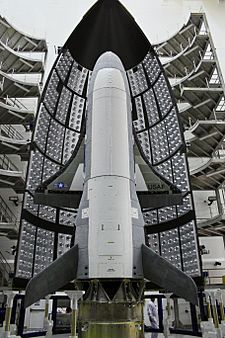Boeing X-37 facts for kids
Quick facts for kids X-37 |
|
|---|---|
 |
|
| The OTV-1 X-37B in April 2010, inside its payload fairing before launch | |
| Role | Uncrewed spaceplane |
| National origin | United States |
| Manufacturer | Boeing Defense, Space & Security |
| First flight | 7 April 2006 (first drop test) |
| Introduction | 22 April 2010 (first spaceflight) |
| Status |
|
| Primary user |
|
| Number built |
|
| Developed from | Boeing X-40 |
The Boeing X-37 is a special unpiloted (meaning no human pilot) spaceplane. It's like a small, reusable robotic spacecraft. Its main job is to test new technologies for space travel while it's in orbit around Earth. It also tests how these technologies work when it comes back through Earth's atmosphere. The X-37 is based on an earlier, smaller spacecraft called the X-40. NASA started the X-37 project in 1999. Then, in 2004, it was moved to the U.S. Department of Defense. The X-37 first flew as a test in April 2006. It began its first space mission for the United States Air Force in April 2010.
Contents
History of the X-37 Spaceplane
Early Development with NASA
In 1999, NASA chose the company Boeing to design the X-37 vehicle. Boeing built the vehicle at its Phantom Works branch in California. By the end of 2002, Boeing received a new contract for $300 million. This was part of NASA’s Space Launch Initiative program.
Transfer to the Department of Defense
In September 2004, the X-37 project moved from NASA to the Defense Advanced Research Projects Agency. DARPA is a part of the U.S. Department of Defense. Since then, the program has become more secretive. It is not known if DARPA will keep it that way.
First Test Flights
In June 2005, the X-37 completed a "captive-carry" flight. This means it was carried underneath another plane, the Scaled Composites White Knight. This test happened at Mojave Air & Space Port in Mojave, California. Later in 2005, the X-37 was updated. Its nose wheel supports were made stronger.
The X-37 had its first free glide flight in April 2006. During its landing, the vehicle went off the runway. After repairs, the program moved to Air Force Plant 42 in Palmdale, California. The White Knight plane continued to fly from Mojave. It would fly to Plant 42 when tests were scheduled. Five more flights were done, including at least one successful free flight and landing.
X-37B Orbital Test Vehicle
In November 2006, the U.S. Air Force announced it would develop a new version. This version, called the X-37B, was based on NASA's X-37A. The Air Force version is known as the X-37B Orbital Test Vehicle (OTV). This OTV program uses money and research from DARPA, NASA, and the Air Force.
The Air Force Rapid Capabilities Office leads the X-37B project. They work with NASA and the Air Force Research Laboratory. Boeing is the main company building the OTV. The X-37B can stay in orbit for up to 270 days at a time. The United States Secretary of the Air Force said the OTV program helps test new technologies. It also develops ideas for reusable space vehicles.
The X-37B was first planned to launch inside the Space Shuttle. But after the Columbia accident, it was moved to a Delta II rocket. Later, it was moved again to the Atlas V rocket. This change happened because of worries about how the spacecraft would fly during launch.
Design of the X-37 Spaceplane
Engines and Fuel
The X-37's main engines use JP-8 kerosene, which is a military jet fuel. Its smaller maneuvering engines use hydrogen peroxide. The X-37 was first designed to launch in the Space Shuttle cargo bay. But it was later changed to launch on Atlas V and Falcon 9 rockets. This was because a shuttle flight would have been too expensive.
Speed and Technology
This vehicle could become the United States' first working military spaceplane. It is expected to fly at speeds up to Mach 25 when it re-enters Earth's atmosphere. Mach 25 is incredibly fast, about 25 times the speed of sound.
The X-37 tests several important technologies. These include better thermal protection systems (to protect it from heat). It also tests avionics (aircraft electronics) and an autonomous guidance system. An autonomous system means it can guide itself without human help. It also tests an advanced airframe (the main body of the aircraft). The engine on board is the Rocketdyne AR-2/3. It uses hydrogen peroxide and JP-8 fuel.
Aerodynamics and Landing
The X-37's shape is similar to the Space Shuttle. This means it flies in a similar way. The test vehicle used for atmospheric glide tests did not have an engine. Instead of payload bay doors, it had a strong, closed upper fuselage (body). This allowed it to connect to a mothership. Most of its heat shield tiles were "fake" and made of foam. Only a few were real TPS tiles, and blankets were used where heating was not as strong.
After their missions, X-37B spacecraft land on a runway. The main landing site is Vandenberg Air Force Base in California. Edwards Air Force Base is used as a backup landing site.
Images for kids
-
The X-37 (far right) is the smallest and lightest orbital spaceplane yet flown. Both the North American X-15 and SpaceShipOne were suborbital. Of the spaceplanes shown, only the X-37 and Buran conducted uncrewed spaceflights.
See also
 In Spanish: Boeing X-37 para niños
In Spanish: Boeing X-37 para niños






